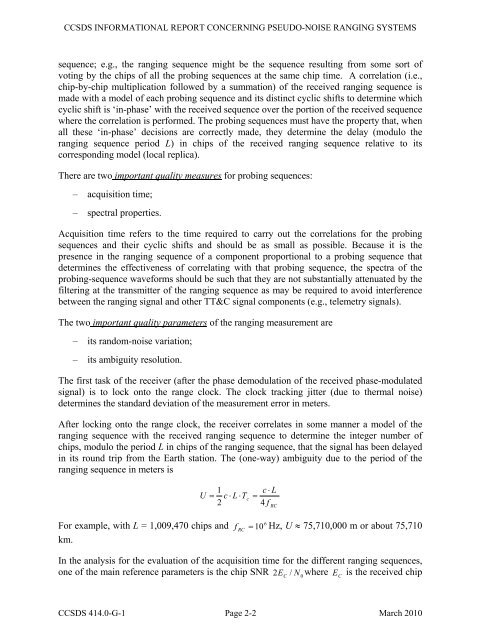Pseudo-Noise (PN) Ranging Systems - CCSDS
Pseudo-Noise (PN) Ranging Systems - CCSDS
Pseudo-Noise (PN) Ranging Systems - CCSDS
You also want an ePaper? Increase the reach of your titles
YUMPU automatically turns print PDFs into web optimized ePapers that Google loves.
<strong>CCSDS</strong> INFORMATIONAL REPORT CONCERNING PSEUDO-NOISE RANGING SYSTEMS<br />
sequence; e.g., the ranging sequence might be the sequence resulting from some sort of<br />
voting by the chips of all the probing sequences at the same chip time. A correlation (i.e.,<br />
chip-by-chip multiplication followed by a summation) of the received ranging sequence is<br />
made with a model of each probing sequence and its distinct cyclic shifts to determine which<br />
cyclic shift is ‘in-phase’ with the received sequence over the portion of the received sequence<br />
where the correlation is performed. The probing sequences must have the property that, when<br />
all these ‘in-phase’ decisions are correctly made, they determine the delay (modulo the<br />
ranging sequence period L) in chips of the received ranging sequence relative to its<br />
corresponding model (local replica).<br />
There are two important quality measures for probing sequences:<br />
– acquisition time;<br />
– spectral properties.<br />
Acquisition time refers to the time required to carry out the correlations for the probing<br />
sequences and their cyclic shifts and should be as small as possible. Because it is the<br />
presence in the ranging sequence of a component proportional to a probing sequence that<br />
determines the effectiveness of correlating with that probing sequence, the spectra of the<br />
probing-sequence waveforms should be such that they are not substantially attenuated by the<br />
filtering at the transmitter of the ranging sequence as may be required to avoid interference<br />
between the ranging signal and other TT&C signal components (e.g., telemetry signals).<br />
The two important quality parameters of the ranging measurement are<br />
– its random-noise variation;<br />
– its ambiguity resolution.<br />
The first task of the receiver (after the phase demodulation of the received phase-modulated<br />
signal) is to lock onto the range clock. The clock tracking jitter (due to thermal noise)<br />
determines the standard deviation of the measurement error in meters.<br />
After locking onto the range clock, the receiver correlates in some manner a model of the<br />
ranging sequence with the received ranging sequence to determine the integer number of<br />
chips, modulo the period L in chips of the ranging sequence, that the signal has been delayed<br />
in its round trip from the Earth station. The (one-way) ambiguity due to the period of the<br />
ranging sequence in meters is<br />
For example, with L = 1,009,470 chips and<br />
km.<br />
1 c ⋅ L<br />
U = c ⋅ L ⋅Tc<br />
=<br />
2 4 f<br />
<strong>CCSDS</strong> 414.0-G-1 Page 2-2 March 2010<br />
RC<br />
6<br />
f RC = 10 Hz, U ≈ 75,710,000 m or about 75,710<br />
In the analysis for the evaluation of the acquisition time for the different ranging sequences,<br />
one of the main reference parameters is the chip SNR 2E / N where C 0 E is the received chip<br />
C

















